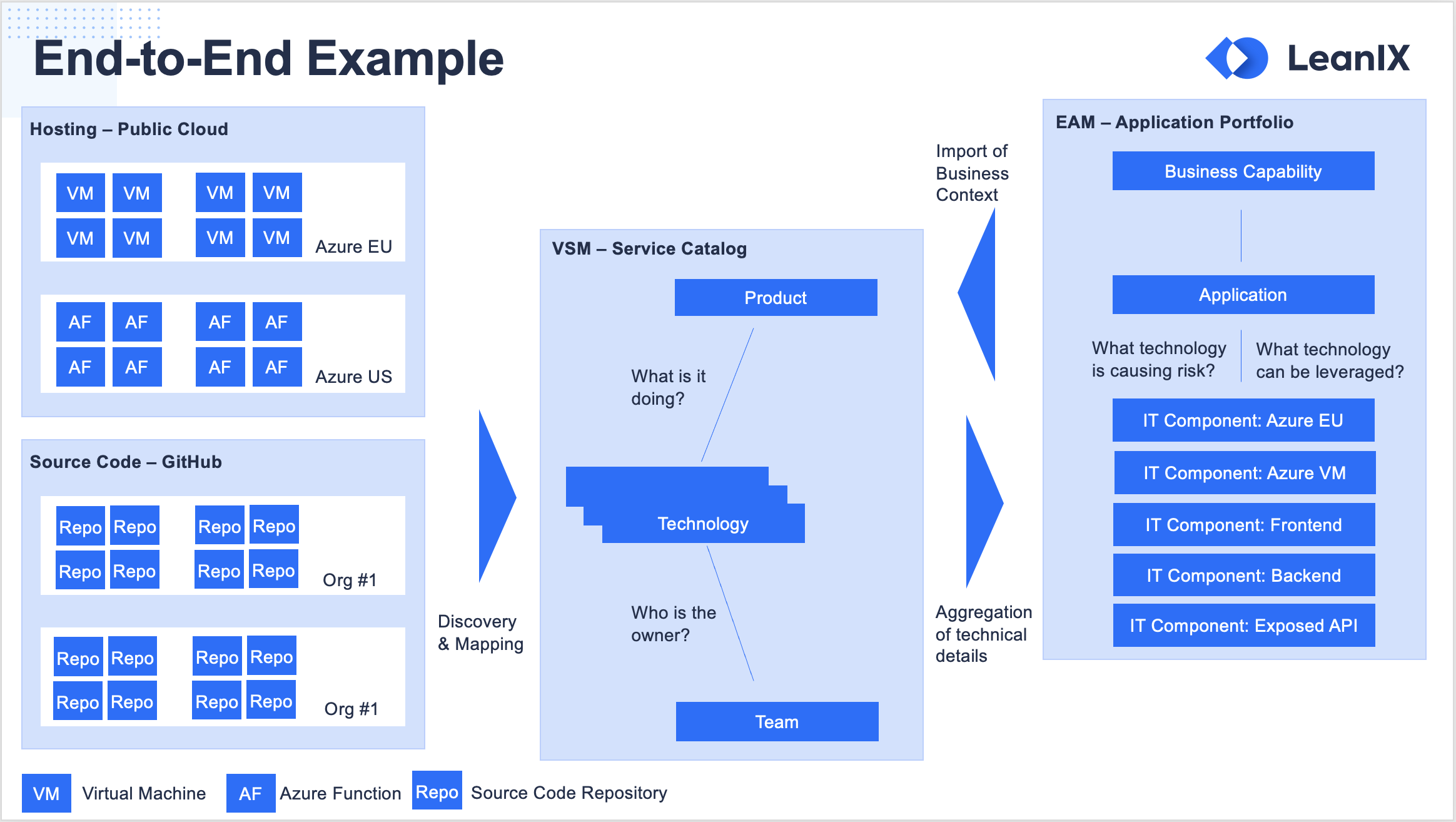VSM for Enterprise Architects
As a modern Enterprise Architect, you are far more than a gate-keeper & manager of an Application Inventory - you are a driver behind Digital Transformation. This page walks you through VSM from an Enterprise Architecture perspective, explaining the Why & How you should engage.
What is Value Stream Management?
VSM is much more than just discovering technologies & dependencies amongst your portfolio.
Teams using Technology to build great Products
LeanIX takes a very opinionated view on Value Streams for Digital Products. We believe that in modern software engineering, enabling & empowering Development Teams is crucial for success - especially in areas where your business very deliberately decides to invest in technology.
For you as Enterprise Architects, there are three main reasons to get interested:
- Faster time-to-value: Get data imported into your EAM workspace - e.g. Microservices mapped to Application, or aggregated data from public cloud like location.
- Risk management: Topics like log4shell amplify the need to discover technical risks automatically
- Align architecture amongst Corporate & Product IT: Instead of only managing the Application Portfolio, a modern EA can do so much more - partnering with their Product IT on hosting excellence or technical skill development.
Learn more about Value Stream Management
A detailed overview of VSM as a discipline can be found here. In particular, DORA is a rapidly emerging standard to objectify Development Efficiency.
Technology discovery via VSM
As an enterprise architect you will want some level of insight into the technical landscape of your development space, data such as cloud costs or the dependency on specific backend services. With the out of the box integration between VSM and EAM a best practice mapping for this synchronization is provided, aiming to map relevant information between both places, while keeping clutter away from stakeholders:

FAQ
Below you will find the most commonly raised questions and their answers around how to bring architecture driven thinking to VSM:
What is a Product in VSM?
Products in VSM reflect the business perspective on your development by representing what an end-user, potentially a customer sees - and which of your microservices, cloud accounts and other technology it relies upon. Together with the Domains, which represent a breakdown of your landscape into technical groupings they bring a logical structure to your development landscape.
How do I manage Products in VSM?
If you are a VSM standalone user you can manage your Products directly in VSM - creating the corresponding fact sheets and linking them to your various automated discovery sources to make sure dependency information is always up to date. You can further manage certain business relevant information directly on the fact sheet as well, such as the responsible Product Owner, Criticality and more.
If you’re also a LeanIX EAM customer we offer an out of the box integration that directly maps your EAM landscape to your VSM landscape. This allows you to take advantage of the information you model and maintain in EAM on application fact sheets by automatically syncing it with the VSM product fact sheets - so there’s no additional manual effort if you want to see Application information such as the Responsibles directly in VSM. This synchronization is bi-directional and also allows you to bring information like your Software Artifacts or your public cloud data discovered in VSM directly to your EAM IT Components to dedicated, new categories.
How can I maintain APIs and how do they relate to Interfaces in EAM?
In VSM APIs are maintained automatically through integrations to tools like Mulesoft that discover them. This allows you to easily pull together an API catalog from multiple sources. Mapped to the corresponding Software Artifacts allows you to trace data flows across your landscape, which can be further enhanced by including information on the specific data objects that are transferred and manipulated.
If you are familiar with our LeanIX EAM data model you will know the interface fact sheet which is used to model the data flows between Applications. These are closely related to the VSM API fact sheet but not a 1:1 mapping. Instead, if you feel the need to see the APIs in your EAM workspace also, they are best mapped as IT Components of a custom type “API” which can then be linked to the Interface - aggregated the technical detail of multiple APIs into one business Interface.
Updated 9 months ago
